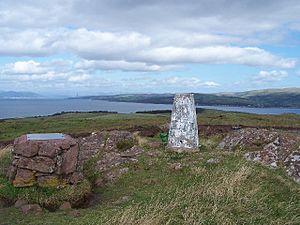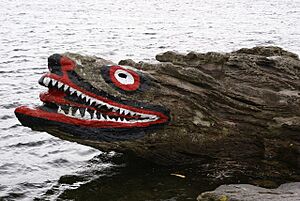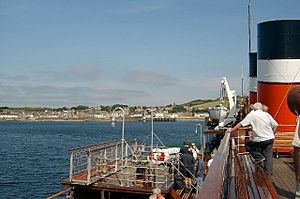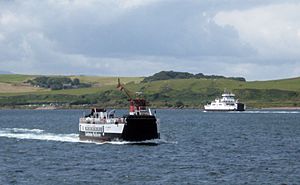Great Cumbrae facts for kids
| Gaelic name | Cumaradh Mòr |
|---|---|
| Norse name | Kumrey |
| Meaning of name | Large island of the Cymric people |
| OS grid reference | NS169566 |
| Coordinates | 55°46′N 4°55′W / 55.77°N 4.92°W |
| Physical geography | |
| Island group | Firth of Clyde |
| Area | 1,168 ha (4.5 sq mi) |
| Area rank | 45 |
| Highest elevation | The Glaidstane 127 metres (417 ft) |
| Administration | |
| Sovereign state | United Kingdom |
| Country | Scotland |
| Council area | North Ayrshire |
| Demographics | |
| Population | 1,376 |
| Population density | 117.8/km2 (305/sq mi) |
| Largest settlement | Millport |
Great Cumbrae, also called Cumbrae or the Isle of Cumbrae, is a lovely island in western Scotland. It's the bigger of two islands known as The Cumbraes, located in the lower Firth of Clyde. This island is a popular holiday spot. It has a beautiful Cathedral of The Isles and a Field Study Centre. You can also find an 18-hole golf course and a road perfect for family bike rides all around the island. Its Scottish Gaelic name is Cumaradh Mòr, and in Scots, it's called Muckle Cumbrae.
Contents
Exploring Great Cumbrae's Geography
Great Cumbrae is about 4 kilometres (2+1⁄2 mi) long and 2 kilometres (1+1⁄4 mi) wide. Its highest point is "The Glaid Stone," a large natural rock 127 metres (417 ft) above sea level. From here, you can see amazing views on a clear day.
Looking north, you can see the Firth of Clyde estuary and mountains like Ben Lomond. To the west, you might spot the larger islands of Bute and Arran. If the weather is very clear, you might even glimpse Northern Ireland to the south.
Millport: The Island's Main Town
Millport is the only town on Great Cumbrae. It stretches around a bay on the island's south coast. About 1,376 people live here, but this number grows a lot in summer. Many people have second homes here for holidays. Most of the land on the island is owned by farmers or the Millport Golf Club.
What's in a Name? The History of Cumbrae
The name Cumaradh comes from Gaelic. It means "place of the Cymric people." These were Brittonic-speaking people from the Kingdom of Strathclyde. The Vikings called the islands Kumreyiar in their old stories.
How the Island Was Formed: Geology Basics
The island is mostly made of sandstone and mudstone. These rocks formed a very long time ago. You can see interesting rock formations like Lion Rock, Crocodile Rock, and Indian's Face. Some of these have even been painted to look more like their names!
The island also has a "raised beach" around it. This is an old coastline that is now higher than the sea. You can see it about 8 metres (26 ft) above the current sea level.
A Look at Great Cumbrae's Past
People have lived on Great Cumbrae since the last ice age ended.
Legends and Early Christianity
A legend says that St Mirin visited Cumbrae around AD 710. He supposedly got rid of all the snakes on the island, just like Saint Patrick did in Ireland. To this day, Cumbrae has no snakes! The Cathedral of The Isles is said to be built where St Mirin preached.
The island has a long connection to Christianity. Old records from 1509 mention two early female missionaries, Saints Baya and Maura.
Battles and Ownership Changes
In 1263, Haakon IV, the King of Norway, might have anchored his fleet off Cumbrae. This was before the Battle of Largs, which was a big fight that didn't have a clear winner.
For many centuries, the island was owned by two different families: the Marquess of Bute and the Earl of Glasgow. In 1999, the last feudal landowner sold his part of the island.
Tourism Through the Years
Tourism became popular in the 20th century. Millport was a favorite stop for Clyde steamers, especially for families from Glasgow going on holiday. Today, most visitors come for day trips. You can still ride the historic PS Waverley steamer from Glasgow or Ayr in the summer.
The University Marine Biological Station Millport (UMBSM) was a famous research center on the island. It studied sea life and attracted students from all over. It closed in 2013, but the site is now run by the Field Studies Council. It's a place where students can learn about nature.
Fun Things to Do on Great Cumbrae
Great Cumbrae is a great place for visitors, especially in summer. The population grows by thousands every weekend!
Cycling and Walking Adventures
A popular activity is hiring a bike and cycling the 11-mile (18-kilometre) coastal road around the island. The roads are usually quiet. There are also many informal walking paths. About 3 mi (5 km) from Millport, on the west coast, you'll find Fintry Bay with a small cafe.
Water Sports and Sea Life
Millport Bay is a popular spot for sailors. The National Watersports Centre offers lessons in activities like powerboating and kayaking. One of the most popular diving spots in the Clyde is near the ferry slip. Divers can explore a Catalina flying boat that sank during World War II.
Other Attractions to Visit
- Cathedral of The Isles is a beautiful church designed by William Butterfield. It opened in 1851 and is one of the smallest cathedrals in Europe. It has lovely gardens and woodlands around it.
- College of the Holy Spirit is next to the cathedral. It used to be a training school for priests. Today, it's a place for retreats and conferences.
- The Wedge is a private house famous for having the narrowest front in the UK – it's only as wide as a front door!
- Museum of the Cumbraes is located in the Garrison building. It tells the story of the island.
- FSC Millport has an aquarium with sea creatures from the Firth of Clyde. It also has a museum about the sea and the Clyde area.
Getting to Great Cumbrae
A Caledonian MacBrayne car ferry connects Great Cumbrae with Largs, Ayrshire on the Scottish mainland. The pier in Millport was built in 1833.
| Preceding station | Ferry | Following station | ||
|---|---|---|---|---|
| Terminus | Caledonian MacBrayne Ferry |
Largs |
Wildlife and Environment Around Cumbrae
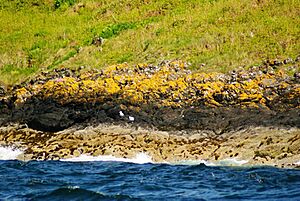
Great Cumbrae has a marine climate. This means it can get strong winds from the Atlantic Ocean. However, the east side of the island, facing Largs, is often much calmer.
Animals and Plants
You can find many animals on the island, including owls, polecats, rabbits, and common kestrels. Sometimes, you might even see a golden eagle or a sea eagle. There are also many seabirds like fulmars and oystercatchers. In the waters around the island, you might spot seals, basking sharks, and dolphins.
Environmental Topics
Cumbrae is close to two nuclear power stations, Hunterston A and Hunterston B, near Fairlie. There is also a wind farm nearby with twelve tall turbines that you can see from Cumbrae. The waters of the Clyde are also home to the UK's nuclear submarines.
New Projects on the Island
There are plans for new projects on Great Cumbrae. For example, a new environmentally friendly facility is being planned at Wine Bay. This facility might include a vegetable garden and composting areas. The goal is for it to become self-sufficient and create jobs for local people.
A forestry project is also underway. Trees are being planted on the hillside above Ballochmartin Farm.
Cumbrae in the Media
The island has been featured in a BBC Radio 4 comedy series called Millport. It was also the focus of a BBC documentary called Seaside Stories, which showed many local businesses and residents.
Images for kids
-
Kayaking in the Firth of Clyde off Little Cumbrae
See also
 In Spanish: Great Cumbrae para niños
In Spanish: Great Cumbrae para niños


